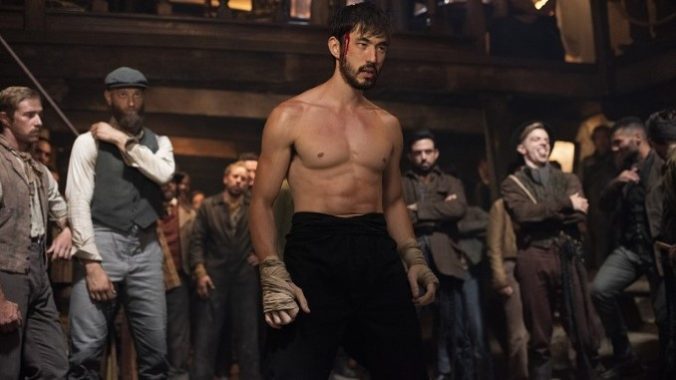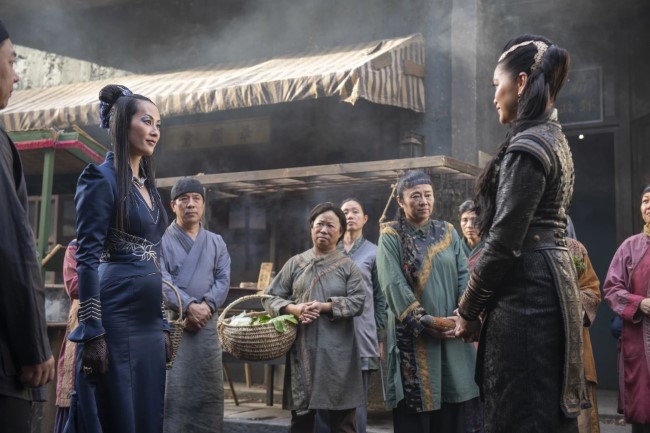TV’s Finest Action Series, Warrior, Is Now on Netflix. Let’s Get it a Final Season
Photo Courtesy of Cinemax
For those who can appreciate the throwing of a solid punch, it’s fair to say we’re currently living in a fruitful era for action TV programming. Increasingly, these types of combat, gunplay, and stunt-heavy shows are associated with Amazon Prime Video, which plays host to the brand new Mr. & Mrs. Smith reboot, alongside a notable slew of dad-friendly action shows that include the likes of Reacher, Hanna, The Boys, and Citadel. In doing so, Amazon effectively inherited the mantle that once belonged to the under-appreciated original programming of Cinemax, highlighted by shows like Banshee and Strike Back before the network finally ditched its originals in 2020. But there was one more engrossing action show that stood alone, one that refused to go down without a fight: Warrior. And wouldn’t you know it, Warrior is now gearing up for not a second but potential third life at Netflix of all places, where all three seasons of the show land today. And if there’s any justice, this move will be followed by the production of a fourth and final season, to bring closure to a story that truly deserves it.
Now, type “warrior” into the Netflix search bar, and you may be faced with a few semi-confusing choices. We’re not talking about the 2011 MMA sports drama feature film with Tom Hardy and Joel Edgerton, which is currently streaming on the service. And we’re certainly not talking about the 2018… Danish language miniseries? …by the same name, which appears to be about rival biker gangs, in a sort of Scandinavian twist on Sons of Anarchy. Ditto for Warrior Nun. The Warrior we’re talking about was birthed by the vision of none other than Bruce Lee, and features bone-crunching kicks that the mixed martial arts world could only dream of—that, and the narrative ambition of prime-era-Game of Thrones, to boot.
Oh, and did we mention it comes with one of the best damn ass-kicking theme songs on TV?
My apologies, for wedging a tune in your subconscious that will more likely than not play on an endless loop for the next week. But the swaggering introduction to Warrior is entirely warranted, and perfectly captures the vibe and aesthetic of one of television’s most beautifully produced period pieces, evoking the complexity of this portrayal of 1870s San Francisco even as it stays true to its action mandate, wantonly tossing stuntmen off balconies and spraying blood across the back alleys of Chinatown.
The initial pitch for Warrior is more or less a tale of family, intermingled with martial arts underworld gang wars. Your would-be protagonist is Ah Sahm (Andrew Koji), a fresh-off-the-boat Chinese martial arts prodigy who arrives in a rapidly expanding and changing San Francisco in the wake of the Civil War, searching for information on the fate of his sister Mai Ling (Dianne Doan), who fled to California years earlier to escape the abuse of her gang lord husband. Taken in by one of the local Chinese criminal gangs known as tongs (the Hop Wei) and ultimately made an indebted member of their brotherhood thanks to his fighting prowess, Ah Sahm is shocked to find that Mai Ling is not only still alive, but doing quite well for herself in San Francisco, having risen up the hierarchy of a rival tong (the Long Zii) by marrying its leader. This natural dyad of gang vs. gang, adopted vs. biological family, is the foundation upon which Warrior is built.
Those pillars were conceived by Bruce Lee in the early 1970s as a series that would have been titled Ah Sahm, presumably starring himself in the title role. He reportedly pitched the series to multiple studios, and was frustrated to see Warner Bros. subsequently launch classic series Kung Fu (with David Carradine) in 1972, feeling that they had more or less retooled his concept to reframe around a white protagonist. It’s unclear how much more of Lee’s initial conceptualization actually exists in Warrior as we know it today, but it’s executive produced by his one living child, Shannon Lee, who has been with the show since its start on Cinemax and single season on Max, where the show was revived for the first time. It certainly represents a key piece of Bruce Lee’s mythologic legacy, and it’s fascinating to consider what it might have looked like starring the icon in the 1970s.
But regardless of those possibilities, the Warrior we were delivered from 2019 onward remains a thing of beauty in its own right. Its initial premise is deceptively simple: Ah Sahm must reconnect with his sister and negotiate the fraught world of inter-tong violence as a fish out of water in a racially charged San Francisco. That could have been plenty of material for a martial arts drama on its own, but Warrior is by no means content to simply focus on the tongs while interjecting the occasional white American antagonist into the proceedings. Rather, it aims for nothing less than a top-to-bottom representation of most every socioeconomic caste present in the city at this moment, from the gilded halls of high society, industry, and government to the gambling taverns and opium dens of the Barbary Coast. Ah Sahm, who initially appears to be our de facto protagonist, rarely feels like a true “main character” at all—he’s just one of a roster of dozens, each with their own secrets and plans to win fortune, or justice, or merely survival for another day.
This narrative ambition, coupled with its lush production values and spectacular period sets and costuming, give the existing three seasons of Warrior a feeling of luxury and prestige one would likely never expect from a show that typically features several arms or legs being hideously broken in any 60-minute span. Its sprawling network of character connections, alliances, deceptions, and veiled threats calls to mind the glory days of a show like Game of Thrones, and the sense that there are so many pieces in motion—so many unique, independent characters with lives of their own and tangled morality—that you genuinely never know what will happen next. Which tongs will rise and fall in the complex criminal hierarchy of Chinatown? Which characters will find themselves facing down a dozen hatchetmen when they turn down the wrong alley?

Warrior, though, has empathy to spare for all of them, regardless of their station. The heart of the show might very well be a character like “Big Bill” O’Hara (Kieran Bew), a corrupt but generally moralistic police sergeant whose gambling addiction and subsequent entanglements lead to making enemies in both Chinatown and City Hall, even as he attempts to hold together a growing family. Or there’s Dylan Leary (Dean Jagger), a hulking Civil War vet and Irish labor activist/anti-Chinese racist, who slowly morphs over the course of three seasons from undeniable antagonist to a tweener attempting to keep the peace while delivering for his own destitute constituency. Or perhaps you’d take a liking to Wang Chao (Hoon Lee), a classic middleman/true neutral character who functions as a black market salesman and information dealer for all sides, or Ah Toy (Olivia Cheng), a brothel-running madam who moonlights as a deadly swordsman taking vengeance on the men who threaten the safety of her courtesans. All of these viewpoint character descriptions are merely skimming the surface of Warrior’s complex dynamic.
-

-

-

-

-

-

-

-

-

-

-

-

-

-

-

-

-

-

-

-

-

-

-

-

-

-

-

-

-

-

-

-

-

-

-

-

-

-

-

-








































